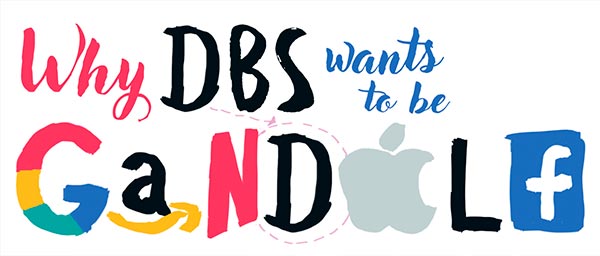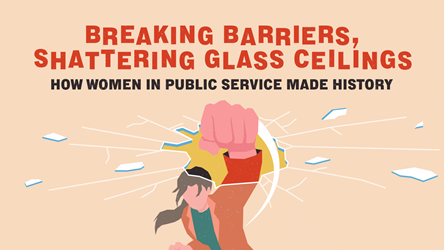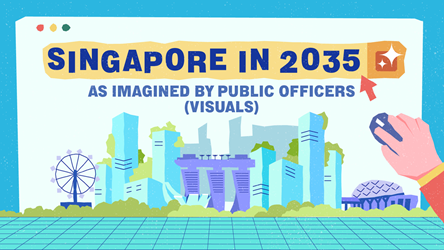Why DBS Wants To Be Gandalf

With so many people carrying smartphones, and banking services available on the go, will physical banks go the way of dinosaurs?
Several years ago, even as DBS Bank was doing well, it observed several trends that could hurt its prospects. Growing the traditional way, such as by acquiring other banks, was not enough. Internet technology platforms like WeChat and Alipay were providing financial services faster, cheaper and on a great scale — and starting to encroach on banking services.
“We realised if we didn’t act quickly, we could get completely disintermediated,” said DBS Chief Information Officer Dave Gledhill at the 2017 Public Service Conference.
Co-presenter Ms Tan Su Shan, DBS Group Head of Consumer Banking and Wealth Management, added that the bank had to innovate, or risk dying. “That paranoia is what drives us to keep disrupting ourselves.”
The number one priority was to conquer the digital world: using data, being social and going mobile-first. That meant going beyond “digital lipstick” — not just launching a website or Facebook page, but rethinking and reimagining the core of how the organisation works to provide a different service experience.
Redefining The Organisation
Like the Public Service, DBS uses the mantra “digitising to the core”. DBS studied how other big technology companies build and use technology to create great experiences. With what they learnt, they imagined a DBS that was very different from a traditional bank and came up with the acronym GANDALF.
G: Using open-source software like Google
A: Running on Amazon’s cloud platforms
N: Using data and automation to scale, and provide personalised recommendations like Netflix
D: DBS as a digital and data bank of Singapore
A: Design like Apple
L: Be a learning community like LinkedIn and push for continuous learning
F: Become more collective like Facebook
The missing element, the letter D, could be where DBS fits in. “It sounds a little bit cheesy,” said Mr Gledhill, “[but it] has driven a massive change in perception about who we are [and] how we build our products and systems.”
As an example of using data and technology, DBS has an overview of its ATMs across the island. With predictive analytics, DBS can tell which ATMs are more frequently used and provide more units in places where customers are more likely to need cash for payments. This reduces the instances of ATMs running empty, and optimises the delivery of cash to ATMs that need to be reloaded.
Walk Through Customers Journey
To provide “joyful experiences”, DBS puts itself in its customers’ shoes to identify what they want to achieve at different moments of their lives. It requires a shift in thinking, from the product-centric ways of traditional banks — selling a mortgage or a credit card — to seeing from the customer’s point of view.
The idea is to identify the customer’s “job to be done”. Once that is nailed down, the next step is to figure out the “clever, quick, seamless ways” to help the customer achieve that task, Ms Tan said.

By identifying moments in customers’ everyday life — e.g., commuting or paying utility bills — DBS can envisage how to integrate its services and products seamlessly into the customers’ journey.
For example, knowing that people need banking services more than physical banks led DBS to start a completely digital bank in India. With Digibank, an app requiring no paperwork, signatures, cash or call centres, customers can open a bank account in just 90 seconds and have queries quickly answered by a chatbot.
Digibank uses biometrics for authentication and artificial intelligence to learn the users’ spending habits. The latter allows DBS to help users optimise their budgets and receive rewards such as dining discounts, as part of DBS’ contextual marketing.
DBS also looks at customers’ episodic life, or significant moments such as buying a car, getting married or buying a house. For example, its staff spent many hours with parents-to-be and new parents at hospitals to understand the journey of having a baby.

Paired with human-centred design thinking, such knowledge of customer experiences allows DBS to combine “emotional value” with the “utilitarian value of getting things done” to deliver services in seamless, intuitive and joyful ways, said Ms Tan.
Building A Culture
While there are departments and leads dedicated to studying customer journeys, DBS wanted to expand this approach to the entire organisation.
About 200 of its top leaders spent a whole day learning about leading customer journeys. That was a huge commitment of time, said Mr Gledhill, taking half the time out of the leaders’ annual gathering for setting the organisation’s strategic agenda. But doing so conveyed the importance of customer journeys to the rest of DBS. Today, it is rare that meetings for any new products do not start with thinking about the customer journey.
When thinking of serving customers, also consider your employees, shared Ms Tan. DBS has an innovation team that does not touch products or services, but focuses entirely on spreading an innovation culture within DBS. Other initiatives include learning opportunities and awards to celebrate failure and encourage a start-up mindset of experimentation.
As Mr Gledhill pointed out, for any organisation’s transformation journey, it is vital to take everyone along, transform people and gear everyone for the digital future.
- POSTED ON
Apr 5, 2018
- TEXT BY
Tuber
- ILLUSTRATION BY
Mushroomhead
-
Deep Dive
A Push for Digital Services









.tmb-tmb450x250.jpg)